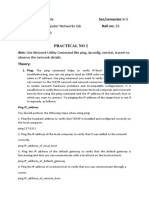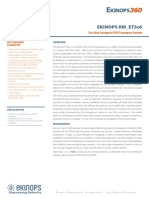NETWORK ENGG USED COMMOND
Troubleshooting Command
1. ping
Usage: ping <destination>
Purpose: Tests connectivity between your device and another device (like a server or
another computer) by sending ICMP echo requests.
Example: ping google.com will check if you can reach Google's servers.
2. tracert (Windows) / traceroute (Linux/Mac)
Usage: tracert <destination> or traceroute <destination>
Purpose: Shows the path that packets take from your device to the destination, listing
each hop along the way.
Example: tracert google.com will display the route taken to reach Google's
servers.
3. ipconfig (Windows) / ifconfig or ip (Linux/Mac)
Usage: ipconfig, ifconfig, or ip a
Purpose: Displays your device’s network configuration, including IP address, subnet
mask, default gateway, and DNS servers.
Example: ipconfig on Windows will show your current IP address.
4. nslookup
Usage: nslookup <domain>
Purpose: Queries the DNS to find the IP address associated with a domain name.
Example: nslookup google.com will return the IP addresses for Google's domain.
5. netstat
Usage: netstat -a or netstat -an
Purpose: Displays active network connections, listening ports, and routing tables.
Example: netstat -an shows all active connections and listening ports.
6. route
Usage: route print (Windows) / route (Linux)
Purpose: Displays the current routing table, showing how your device routes traffic.
Example: route print on Windows shows the routing table.
7. arp
Usage: arp -a
Purpose: Displays the ARP (Address Resolution Protocol) table, mapping IP
addresses to MAC addresses on your local network.
Example: arp -a lists all IP-to-MAC address mappings.
8. netsh (Windows)
Usage: netsh <command>
Purpose: A versatile command used to configure and manage various network
settings.
Example: netsh interface ip show config shows IP configuration for all
interfaces.
9. dig (Linux/Mac)
Usage: dig <domain>
Purpose: Queries DNS servers to retrieve information about domain names, like IP
addresses, MX records, etc.
Example: dig google.com retrieves information about Google's DNS records.
10. tcpdump (Linux) / Wireshark (Cross-Platform)
Usage: tcpdump <options> or use Wireshark with a graphical interface.
Purpose: Captures and analyzes network packets for detailed inspection.
Example: tcpdump -i eth0 captures traffic on the eth0 interface.
11. telnet
Usage: telnet <host> <port>
Purpose: Tests connectivity to a specific port on a remote host. Useful for checking if
a specific service (like HTTP or SSH) is accessible.
Example: telnet google.com 80 tests connectivity to Google's web server.
12. ssh
Usage: ssh <user>@<host>
Purpose: Securely connects to a remote server for administration or troubleshooting.
Example: ssh user@192.168.1.10 connects to a server at that IP address.
13. nmap
Usage: nmap <options> <target>
Purpose: Scans networks for open ports, services, and devices. Useful for security
auditing and discovering hosts.
Example: nmap -sP 192.168.1.0/24 scans the specified subnet for active hosts.
These commands are essential for diagnosing network issues, ranging from connectivity
problems to DNS issues and more.






















































































